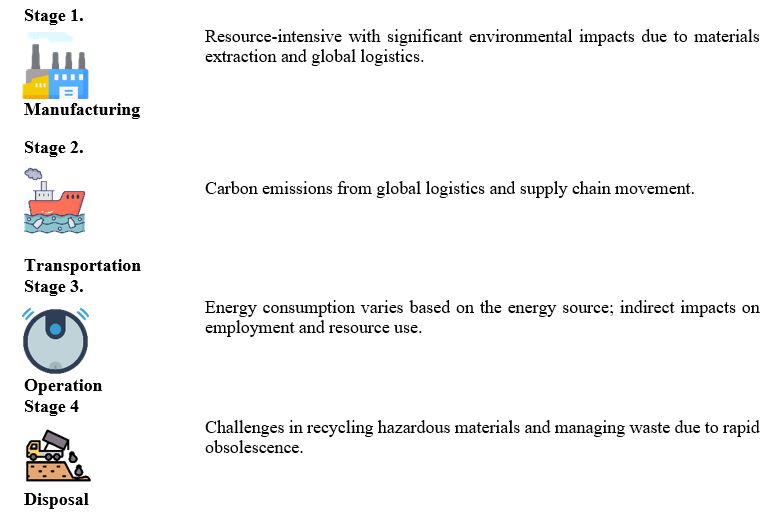Conceptualizing a Life Cycle Assessment (LCA) Model for Cleaning Robots

Abstract
Robotics has become increasingly prevalent in various sectors, including domestic and industrial cleaning. As their usage grows, so does the need to understand and mitigate their environmental impacts. Life Cycle Assessment (LCA) is a recognized method for assessing the environmental impacts of products and services throughout their life cycle, from production to disposal. It helps in identifying key areas where environmental impacts are significant and in developing strategies for mitigation. Despite its widespread application in various industries, the specific application to cleaning robots remains under-explored. This study introduces a conceptual model for a Life Cycle Assessment (LCA) method for cleaning robots. It identifies key environmental impact indicators across four major stages of a cleaning robot's life cycle: production, transport, operations, and end-of-life. The purpose is to provide a comprehensive method for future assessments of the ecological footprint of these robots. In the production phase, the proposed model suggests evaluating greenhouse gas (GHG) emissions, carbon intensity, the share of renewable energy used, and the proportion of recycled or renewable materials in manufacturing. These indicators aim to quantify the environmental impacts associated with the manufacturing process of cleaning robots. The transportation stage is conceptualized to include assessments of GHG emissions during transit, the carbon intensity of transport methods, and the use of low-carbon and renewable energy in logistics. This aspect of the assessment focuses on the environmental impact of distributing cleaning robots from manufacturers to end-users. For the operational phase, the model proposes metrics such as electricity consumption, renewable electricity usage, Power Usage Effectiveness (PUE), and Carbon Usage Effectiveness (CUE). These indicators are designed to measure the energy efficiency and carbon footprint of cleaning robots during their use. The end-of-life stage includes metrics like the total electronic waste (E-Waste) generated, recycling rates, Electronics Disposal Efficiency (EDE), and the percentage of e-waste sent to landfills. These indicators evaluate the environmental impact of cleaning robots at the end of their usable life and for guiding sustainable disposal and recycling practices. This research attempts to contribute to the broader field of sustainable robotics by providing a framework to evaluate and improve the environmental performance of cleaning robots.
Keywords
Life Cycle Assessment (LCA), Environmental Impact, Cleaning Robots, Sustainability in Robotics, Carbon Footprint, Energy Efficiency, E-Waste Management